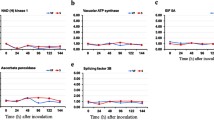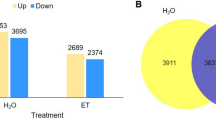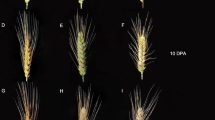Abstract
Leaf necrosis induced by fungal pathogens is one of the most devastating diseases of yam. The objectives of this study were to examine the production of defensive phytohormones and perform a comparative transcriptome analysis between two yam cultivars with different resistance levels against Botrytis cinerea inoculation. After inoculation with B. cinerea, the endogenous ethylene level was found to have accumulated to a higher level in the MH1 resistant cultivar. Meanwhile, expression profiles identified differential defense regulation of ethylene pathway in MH1 (versus susceptible cv. MH3) in response to B. cinerea. A number of ethylene-synthesis and -responsive genes were expressed at higher levels in MH1 than in MH3 after inoculation. Furthermore, ethylene supplementation in MH3 plants by ethephon spraying indeed enhanced the resistance against B. cinerea and Colletotrichum alatae, and elevated the expression of DaEIN2 and DaERF96. Our work improves understanding of defense mechanism and highlights the function of ethylene potentially utilized for yam protection against diseases.






Similar content being viewed by others
Abbreviations
- B. cinerea :
-
Botrytis cinerea
- Chl:
-
Chlorophyll
- EIL:
-
Ethylene-insensitive 3 like
- ERF:
-
Ethylene-responsive transcription factor
- ET:
-
Ethylene
- JA:
-
Jasmonic acid
- MH:
-
Minghuai
- RPKM:
-
Reads per kilobase per million mapped reads
- SA:
-
Salicylic acid
References
Alexander L, Grierson D (2002) Ethylene biosynthesis and action in tomato: a model for climacteric fruit ripening. J Exp Bot 53:2039–2055
Amorim A, Lidiane L, da Fonseca dos Santos R, Pacifico Bezerra Neto J, Guida-Santos M, Crovella S, Maria Benko-Iseppon A (2017) Transcription factors involved in plant resistance to pathogens. Curr Protein Pept Sci 18:335–351
Broekgaarden C, Caarls L, Vos IA, Pieterse CM, Van Wees SC (2015) Ethylene: traffic controller on hormonal crossroads to defense. Plant Physiol 169:2371–2379
Bu Q, Jiang H, Li CB, Zhai Q, Zhang J, Wu X, Sun J, Xie Q, Li C (2008) Role of the Arabidopsis thaliana NAC transcription factors ANAC019 and ANAC055 in regulating jasmonic acid-signaled defense responses. Cell Res 18:756
Catinot J, Huang JB, Huang PY, Tseng MY, Chen YL, Gu SY, Lo WS, Wang LC, Chen YR, Zimmerli L (2015) ETHYLENE RESPONSE FACTOR 96 positively regulates A rabidopsis resistance to necrotrophic pathogens by direct binding to GCC elements of jasmonate- and ethylene-responsive defence genes. Plant Cell Environ 38:2721–2734
Chen L, Zhang L, Yu D (2010) Wounding-induced WRKY8 is involved in basal defense in Arabidopsis. MolPlant–Microbe Interact 23:558–565
Chen Z, Lu H-H, Hua S, Lin K-H, Chen N, Zhang Y, Chen S-P (2019) Cloning and overexpression of the ascorbate peroxidase gene from the yam (Dioscorea alata) enhances chilling and flood tolerance in transgenic Arabidopsis. J Plant Res 132:1–10
Cole RD, Anderson GL, Williams PL (2004) The nematode Caenorhabditis elegans as a model of organophosphate-induced mammalian neurotoxicity. Toxicol Appl Pharmacol 194:248–256
Cooper DC (2012) Mobile image ratiometry for the detection of Botrytis cinerea (Gray Mold). Nat Preced 6989:1
Demir S, ÇELİKEL FG (2019) Effects of plant growth regulators on the plant height and quantitative properties of Narcissus tazetta. Turk J Agric For 43(1):105–114
Duan X, Cai C, Yang Y, Chen F, Sang Z, Ma L (2019) Fall ethephon application enhances the freezing tolerance of Magnolia wufengensis during overwintering. Forests 10:868
Egesi C, Onyeka T, Asiedu R (2007) Severity of anthracnose and virus diseases of water yam (Dioscorea alata L.) in Nigeria I: effects of yam genotype and date of planting. Crop Prot 26:1259–1265
El-Kazzaz M, Sommer N, Kader A (1983) Ethylene effects on in vitro and in vivo growth of certain postharvest fruit-infecting fungi. Phytopathology 73:998–1001
Gao H, Xia X, An L, Xin X, Liang Y (2017) Reversion of hyperhydricity in pink (Dianthus chinensis L.) plantlets by AgNO3 and its associated mechanism during in vitro culture. Plant Sci 254:1–11
Glazebrook J (2005) Contrasting mechanisms of defense against biotrophic and necrotrophic pathogens. Annu Rev Phytopathol 43:205–227
Hua L, Yong C, Zhanquan Z, Boqiang L, Guozheng Q, Shiping T (2018) Pathogenic mechanisms and control strategies of Botrytis cinerea causing post-harvest decay in fruits and vegetables. Food Qual Saf 2(3):111–119
Huang P-Y, Catinot J, Zimmerli L (2015) Ethylene response factors in Arabidopsis immunity. J Exp Bot 67:1231–1241
Ijato JY (2019) Fungal pathogens of yam (Dioscorea rotundata Poir) and their bio-control. Life Sci J 16(9):92–94. https://doi.org/10.7537/marslsj160919.11
Ishihama N, Yoshioka H (2012) Post-translational regulation of WRKY transcription factors in plant immunity. Curr Opin Plant Biol 15:431–437
Li T, Zhang J, Tang J, Liu Z, Li Y, Chen J, Zou L (2020a) Combined use of Trichoderma atroviride CCTCCSBW0199 and brassinolide to control Botrytis cinerea infection in tomato. Plant Dis. https://doi.org/10.1094/PDIS-07-19-1568-RE
Li Z, Liu H, Ding Z, Yan J, Yu H, Pan R, Hu J, Guan Y, Hua J (2020b) Low temperature enhances plant immunity via salicylic acid pathway genes that are repressed by ethylene. Plant Physiol 182:626–639
Lin HF, Xiong J, Zhou HM, Chen CM, Lin FZ, Xu XM, Oelmüller R, Xu WF, Yeh K-W (2019) Growth promotion and disease resistance induced in anthurium colonized by the beneficial root endophyte Piriformospora indica. BMC Plant Biol 19(1):40
Liu X, Inoue H, Hayashi N, Jiang C-J, Takatsuji H (2016) CC-NBS-LRR-type R proteins for rice blast commonly interact with specific WRKY transcription factors. Plant Mol Biol Rep 34:533–537
Ma J, Lin F, Qin W, Wang P (2004) Differential response of four cyanobacterial and green algal species to triazophos, fentin acetate, and ethephon. Bull Environ Contam Toxicol 73:890–897
Massee G (1908) Fungi exotici: VIII. Bull Miscel Inf 216–219
Minocha R, Martinez G, Lyons B, Long S (2009) Development of a standardized methodology for quantifying total chlorophyll and carotenoids from foliage of hardwood and conifer tree species. Can J For Res 39:849–861
Mutlu A, Öktem A (2017) Effect of different ethephon doses to plant height, lodging and grain yield of durum wheat (Triticum durum L.). Mediterr Agric Sci 30:53–58
Okigbo RN (2003) Mycoflora of tuber surface of white yam (Dioscorea rotundata Poir) and postharvest control of pathogens with Bacillus subtilis. Mycopathologia 156(2):81–85
Polycarp D, Afoakwa E, Budu A, Otoo E (2012) Characterization of chemical composition and anti-nutritional factors in seven species within the Ghanaian yam (Dioscorea) germplasm. Intern Food Res J19:985–992
Popoola AR, Adedibu BO, Ganiyu SA (2013) Rapid assessment of resistance of tissue-cultured water yam (Dioscorea alata) and white guinea yam (Dioscorea rotundata) to anthracnose (Colletotrichum gloeosporioides Penz.). Arch Phytopathol Plant Prot 46:663–669
Saltveit ME (1999) Effect of ethylene on quality of fresh fruits and vegetables. Postha Biol Technol 15:279–292
Shuai Z, Shixiong L, Taixin Y (2013) Co-toxicity and effect of mixtures of difenoconazole and pyraclostrobin against Colletotrichum gloeosporioides on yam. Plant Prot 39::160–163
Soares ACF, Sousa CS, Garrido MS, Perez JO, Almeida NS (2006) Soil streptomycetes with in vitro activity against the yam pathogens Curvularia eragrostides and Colletotrichum gloeosporioides. Braz J Microbiol 37(4):456–461
Song S, Huang H, Gao H, Wang J, Wu D, Liu X, Yang S, Zhai Q, Li C, Qi T (2014) Interaction between MYC2 and ETHYLENE INSENSITIVE3 modulates antagonism between jasmonate and ethylene signaling in Arabidopsis. Plant Cell 26:263–279
Soto-Suárez M, Baldrich P, Weigel D, Rubio-Somoza I, San Segundo B (2017) The Arabidopsis miR396 mediates pathogen-associated molecular pattern-triggered immune responses against fungal pathogens. Sci Rep 7:44898
Wang D, Amornsiripanitch N, Dong X (2006) A genomic approach to identify regulatory nodes in the transcriptional network of systemic acquired resistance in plants. PLoS Pathogen 2:e123
Wild M, Davière J-M, Cheminant S, Regnault T, Baumberger N, Heintz D, Baltz R, Genschik P, Achard P (2012) The Arabidopsis DELLA RGA-LIKE3 is a direct target of MYC2 and modulates jasmonate signaling responses. Plant Cell 24:3307–3319
Winch J, Newhook F, Jackson G, Cole J (1984) Studies of Colletotrichum gloeosporioides disease on yam, Dioscorea alata, in Solomon Islands. Plant Pathol 33:467–477
Windram O, Madhou P, McHattie S, Hill C, Hickman R, Cooke E, Jenkins DJ, Penfold CA, Baxter L, Breeze E (2012) Arabidopsis defense against Botrytis cinerea: chronology and regulation deciphered by high-resolution temporal transcriptomic analysis. Plant Cell 24:3530–3557
Xing X, Li X, Zhang M (2017) Transcriptome analysis of resistant and susceptible tobacco (Nicotiana tabacum) in response to root-knot nematode Meloidogyne incognita infection. Biochem Biophy Res Commun 482:1114–1121
Yang Y-X, Ahammed J, Wu G, Fan C, Zhou SY Y-H (2015) Crosstalk among jasmonate, salicylate and ethylene signaling pathways in plant disease and immune responses. Curr Protein Pept Sci 16:450–461
Yoosukyingsataporn S, Detpiratmongkol S (2019) Effects of ethephon on growth and yield of sweet sorghum (Sorghum bicolor L. Moench) at different growth stages. Iran J Plant Physiol 10(1):2987–2887
Zhang X, Zhu Z, An F, Hao D, Li P, Song J, Yi C, Guo H (2014) Jasmonate-activated MYC2 represses ETHYLENE INSENSITIVE3 activity to antagonize ethylene-promoted apical hook formation in Arabidopsis. Plant Cell 26:1105–1117
Zhao Y, Wei T, Yin KQ, Chen Z, Gu H, Qu LJ, Qin G (2012) Arabidopsis RAP2. 2 plays an important role in plant resistance to Botrytis cinerea and ethylene responses. New Phytol 195:450–460
Zheng H, Dong L, Han X, Jin H, Yin C, Han Y, Li B, Qin H, Zhang J, Shen Q, Zhang K, Wang D (2020) The TuMYB46L-TuACO3 module regulates ethylene biosynthesis in einkorn wheat defense to powdery mildew. New Phytol 225:2526–2541
Zhu X, Zhu J-K (2013) Double repression in jasmonate-mediated plant defense. Mol Cell 50:459–460
Acknowledgements
This work was supported by the Fujian Provincial Department of Science and Technology, China (Grants 2018N0069 and 2019N0045). We really appreciate to Dr. D. Chamberlin for English polishing, Dr. C.P. Cheng for providing B. cinerea, and Y. Cao for providing C. alatae.
Author information
Authors and Affiliations
Contributions
All authors contributed to the study conception and design. Material preparation, data collection and analysis were performed by SH, ZC, LL, YZ, JY, and S-PC. The first draft of the manuscript was written by K-HL and S-PC and all authors commented on previous versions of the manuscript. All authors read and approved the final manuscript.
Corresponding author
Ethics declarations
Conflict of interest
The authors declare that they have no conflict of interest.
Additional information
Publisher's Note
Springer Nature remains neutral with regard to jurisdictional claims in published maps and institutional affiliations.
Electronic supplementary material
Below is the link to the electronic supplementary material.
Rights and permissions
About this article
Cite this article
Hua, S., Chen, Z., Li, L. et al. Differences in immunity between pathogen-resistant and -susceptible yam cultivars reveal insights into disease prevention underlying ethylene supplementation. J. Plant Biochem. Biotechnol. 30, 254–264 (2021). https://doi.org/10.1007/s13562-020-00582-9
Received:
Accepted:
Published:
Issue Date:
DOI: https://doi.org/10.1007/s13562-020-00582-9




